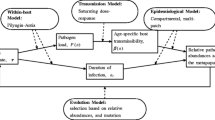Abstract
We develop a structured metapopulation model for vertically transmitted symbionts in natural host populations. We focus primarily on two questions
• Are mutualism and high transmission probability prerequisites for the survival of symbionts in structured host metapopulations?
• What are the ecological conditions under which coexistence of infected and uninfected hosts is possible?
We start with studying in depth the case of qualitatively identical patches and derive conditions for invasion and coexistence of uninfected and infected hosts. Our model predicts that, in a qualitatively uniform environment, coexistence is possible only if the symbionts increase the fitness of their host, so the mutualism is indeed needed for coexistence. We also prove that evolution selects for 100% infection frequency in the metapopulation.
Then we generalize the model for different patch qualities and get conditions for invasion in a virgin environment.
Similar content being viewed by others
References
Breen, J. P. (1994). Acremonium endophyte interactions with enhanced plant resistance to insects. Ann. Rev. Entomol. 39, 401–423.
Clay, K. (1990). Fungal endophytes of grasses. Ann. Rev. Ecol. Syst. 21, 275–279.
Clay, K. and J. Holah (1999). Fungal endophytes symbiosis and plant diversity in successional fields. Science 285, 1742–1744.
Diekmann, O., M. Gyllenberg and J. A. J. Metz. Steady states analysis of structured population models (submitted).
Diekmann, O., M. Gyllenberg, J. A. J. Metz and H. R. Thieme (1993). The cumulative formulation of (physiologically) structured population models, in Evolution Equations, Control Theory and Biomathematics, G. Lumer Ph. Clement (Ed.), New York: Marcel Dekker, pp. 145–154.
Diekmann, O., M. Gyllenberg, J. A. J. Metz and H. R. Thieme (1998). On the formulation and analysis of general deterministic structured population models. I. Linear theory. J. Math. Biol. 36, 349–388.
Diekmann, O., M. Gyllenberg, J. A. J. Metz and H. R. Thieme (2001). On the formulation and analysis of general deterministic structured population models. II. Nonlinear theory. J. Math. Biol. 43, 157–189.
Ewald, P. W. (1987). Transmission modes and evolution of the parasitism-mutualism continuum. Ann. NY Acad. Sci. 503, 295–306.
Fine, P. E. M. (1975). Vectors and vertical transmission: an epidemiologic perspective. Ann. NY Acad. Sci. 266, 173–194.
Gyllenberg, M. and I. Hanski (1997). Habitat deterioration, habitat destruction, and metapopulation persistence in a heterogeneous landscape. Theor. Popul. Biol. 52, 198–215.
Gyllenberg, M., I. Hanski and A. Hastings (1997). Structured metapopulation models, in Metapopulation Dynamics: Ecology, Genetics and Evolution, M. Gilpin and I. Hanski (Eds), London: Academic Press, pp. 93–122.
Gyllenberg, M., I. Hanski and J. A. J. Metz (2002). Viability and persistence of metapopulations, in Evolutionary Conservation Biology (to appear), D. Couvet, R. Ferriére and U. Dieckmann (Eds), Cambridge University Press.
Gyllenberg, M. and J. A. J. Metz (2001). On fitness in structured metapopulations. J. Math. Biol. 43, 545–560.
Hanski, I. (1999). Metapopulation Ecology, Oxford Series in Ecology and Evolution.
Hanski, I. and M. E. Gilpin (1997). Metapopulation Biology: Ecology, Genetics and Evolution, Academic Press.
Herre, E. A. (1993). Population structure and the evolution of virulence in nematode parasites of fig wasps. Science 259, 1442–1445.
Hoveland, C. S. (1993). Importance of economic significance of the acremonium endophytes: a continuum of interactions with host plants. Agriculture, Ecosystems and Environment 44, 3–12.
Lipsitch, M., A. Nowak, D. Ebert and R. May (1995). The population dynamics of vertically and horizontally transmitted parasites. Proc. R. Soc. Lond. B: Biol. Sci. 260, 321–327.
Lipsitch, M., S. Sillerand and A. Nowak (1996). The evolution of virulence in pathogens with vertical and horizontal transmission. Evolution 50, 1729–1741.
Metz, J. A. J. and M. Gyllenberg (2001). How should we define fitness in structured metapopulation models? Including an application to the calculation of evolutionary stable dispersal strategies. Proc. R. Soc. Lond. B 268, 499–508.
Saikkonen, K. (2000). Kentucky-31, far from home. Science 287, 1887a.
Saikkonen, K., S. H. Faeth, M. Helander and T. J. Sullivan (1998). Fungal endophytes: a continuum of interactions with host plants. Ann. Rev. Ecol. Syst. 29, 319–343.
Saikkonen, K., D. Ion and M. Gyllenberg (2002). The persistence of vertically transmitted fungi in grass metapopulations. Proc. R. Soc. Lond. B: Biol. Sci. 269, 1397–1403.
Wilkinson, D. M. and T. N. Sherratt (2001). Horizontally acquired mutualisms, an unsolved problem in ecology? Oikos 92, 377–384.
Author information
Authors and Affiliations
Corresponding author
Rights and permissions
About this article
Cite this article
Gyllenberg, M., Preoteasa, D. & Saikkonen, K. Vertically transmitted symbionts in structured host metapopulations. Bull. Math. Biol. 64, 959–978 (2002). https://doi.org/10.1006/bulm.2002.0309
Received:
Accepted:
Issue Date:
DOI: https://doi.org/10.1006/bulm.2002.0309




